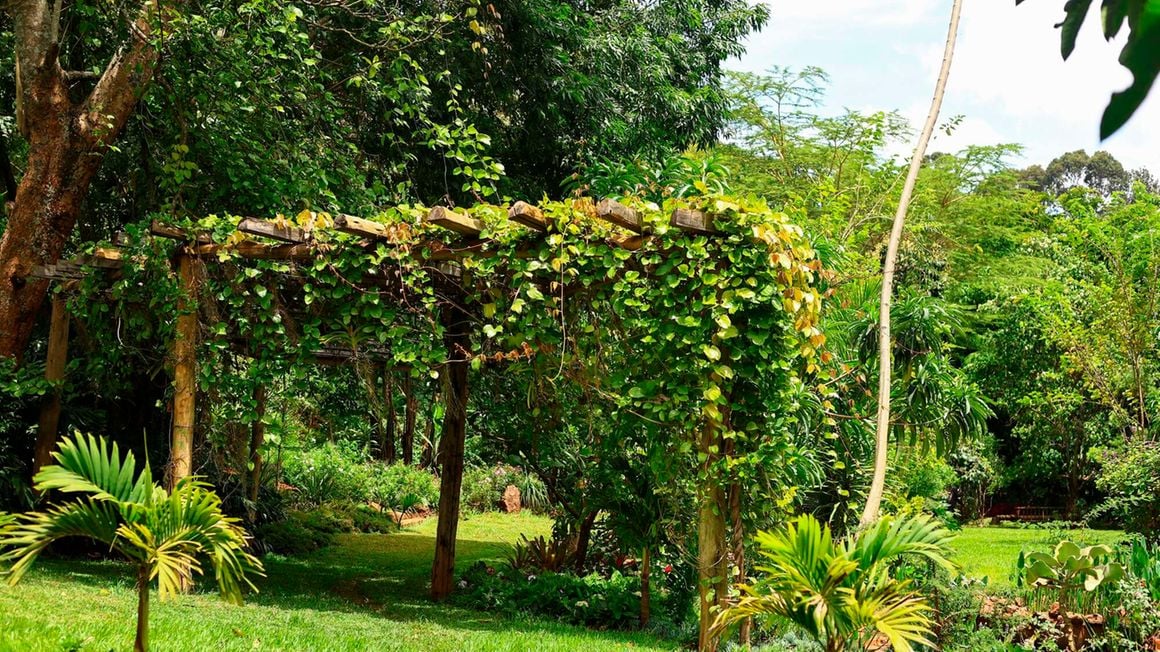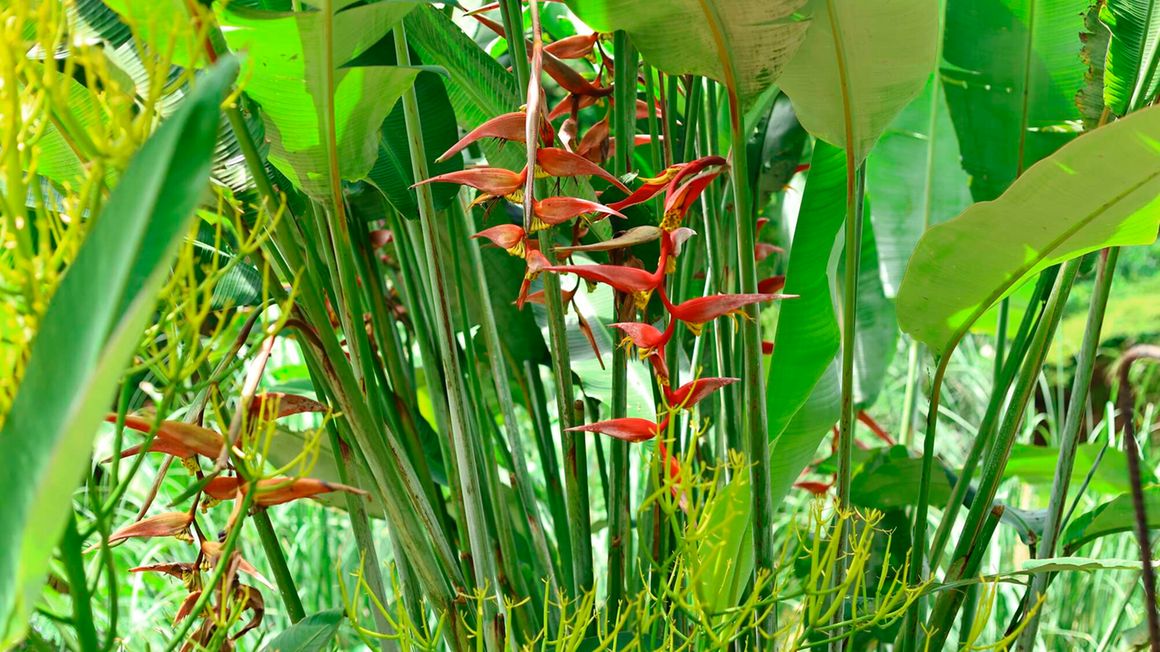
Chief Executive Officer of Maarifa Park Botanical Garden in Kitisuru, Arjun Kohli during an interview on April 24, 2023. PHOTO | KENNEDY AMUNGO | NMG
It is all green and splendorous at Maarifa Park Botanical Garden in Nairobi’s Kitisuru.
As we drive through this private garden owned by the Kohli family, we are welcomed
by blue plumbago flowers to the right, guinea fowls whistling to alert the homeowners of the presence of unfamiliar people in the compound, and ducks and geese waddling back to their houses.I meet Arjun Kohli at this family garden that he has created for over 10 years. Despite being in recovery from a leg surgery, he is still willing to give us a tour of his two-acre family garden which oozes beauty and creativity.
The well-trimmed lawn has paspalum, mixed with Zimbabwean grass.
With over 500 species of different plants, Mr Kohli has converted his garden into a well-designed space with each of the plant species carefully planted in their own space.
Apart from the chirping birds that have built nests in the many trees spread across the garden, he also has ducks, geese, guinea fowls, and peacocks.
Peafowl Bird at Maarifa Park Botanical Garden in Kitisuru on April 24, 2023. PHOTO | KENNEDY AMUNGO | NMG
“We have the regular guinea fowl, the vulturine guinea fowl, the Indian runner ducks, mallard ducks, and peacocks. The birds bring life to the garden,” he says.
Ten years ago, Maarifa Park Botanical Garden was an idle land.
On return to Kenya from pursuing his education in the United Kingdom, Mr Kohli sought to convert his family’s bare two-acre property into a green space where his ageing parents could find some tranquillity and take peaceful evening walks.
“I thought to myself, ‘If I do not start conserving the environment and planting trees, then I am not doing a service to humanity and I have nothing significant to leave for the next generation.’ We have used this garden for sound baths, meditation, and yoga. There is a spiritual element to this garden,” he says.
The University of Edinburgh Philosophy graduate and holder of a Master of Political Science in African Studies at the University of Oxford had no previous landscaping experience. But he designed the garden all by himself.
“It was all my creativity. I went to some landscapers who told me that I have so much imagination though I hadn’t trained in landscaping if I put my mind to it, I could design the garden myself.”
Thrown into the deep end, he got his brain-racking.
Vulturine guineafowl at Maarifa Park Botanical Garden in Kitisuru on April 24, 2023. PHOTO | KENNEDY AMUNGO | NMG
“I realised that the land had three different levels, the riparian, mid, and high level. On the high level, we did a hanging garden. I also wanted plenty of ground for lawns and thought a lot about colour. You see it all over, for instance, in this one bush, I have put yellows, blues and whites,” he says.
The garden is divided into different beds with different themes. Some are themed by colour, and others by species of flowers.
He sourced the trees from different nurseries across the country. Wherever he travels, he brings back new plants. “We have different varieties of guava, passion, avocado, mangoes, orange, lime, loquat, and jack fruit trees,” he says.
Two chocolate-coloured Labradors, Safi and Zuri, walk with us as Mr Kohli takes us on the garden tour. Not one to leave their master for too long, the dogs take a dip in the pond and then rush back to him. On cue, they pose for a photo with the BDLife or at least they attempt to pose.
On the riparian part of the garden, Mr Kohli has planted many water-loving plants.
“There is a permanent river that passes at the edge of the garden making it a bad place to build. It needs plants that like wet roots such as this Raffia palm. On another part of the riparian land, we have the Phoenix palm,” he says.
He did most of the designing in the garden during the Covid-19 period as he had more time on his hands. It provided a good place for family lunches and small family gatherings. The garden has been instrumental to the Kohli family.
Chief Executive Officer of Maarifa Park Botanical Garden in Kitisuru, Arjun Kohli with his wife, Stacy Kohli, pose for a photo during an interview in Kitisuru on April 24, 2023. PHOTO | KENNEDY AMUNGO | NMG
“During the pandemic, when everyone was indoors, we would hold our little family lunches and dinners in the garden. When my dad was still alive, evening walks in the garden were key to helping him relax, unwind and take it easy,” he says.
A hedge of the Yesterday, Today and Tomorrow plant, a seasonal flower that smells heavenly, surrounds part of the garden that the family uses for picnics. Its sweet fragrance is very relaxing. The plants start out purple, gradually fade to lavender, and then become white.
With the rainy season here with us, the Maarifa garden has lush foliage consisting of giant monstera plants, Elephant ears, and fuchsias. The moonflowers are also in season. Having one species of green colour makes it all calming.
With hundreds of flowers in the garden, it is hard to pick a favourite. But Mr Kohli says his favourite is the mucuna vine, a creeping plant.
So great was his love for the mucuna that he built a trellis with reclaimed electricity poles to house it and allow it to grow. The mucuna vine has taken over three years to exhibit its beauty.
Wide shot of Maarifa Park Botanical Garden in Kitisuru on April 24, 2023. PHOTO | KENNEDY AMUNGO | NMG
“I love the mucuna vine because it is very hard to find as you have to wait for it to propagate. I had to wait two years to finally get it. On the trellis, there is also the queenly violent cup and saucer vine, [also known as cathedral bells because of its flower shape]. It looks like somebody is holding a cup of tea,” remarks Mr Kohli.
Thirsty garden
No garden can look this outstanding without a constant flow of water. In the garden, there is a pond that is used to irrigate the plants during the dry season.
“We have an irrigation system that runs underground capturing water from the river. The pond forms a central point where the pumped water comes from. We also have tap water which also forms a huge part of the irrigation system for our farm. This is a very thirsty garden,” he says.
Chief Executive Officer of Maarifa Park Botanical Garden in Kitisuru, Arjun Kohli during an interview on April 24, 2023. PHOTO | KENNEDY AMUNGO | NMG
Mr Kohli has two full-time gardeners who mow the lawn, trim the hedges and prune the plants. For the fertiliser, he has created his own compost piles.
“Every once a year, we top-dress the garden. Now most of the work is in the aftercare of the garden as we have done so much planting. Over time, the plants get so big and lush so most of the work is to prune to allow each garden to grow,” he says.
So passionate is he about the city garden that he does the labelling of the plants by himself. “I have 300 species left for me to label. I label the plants with both the scientific and the common name,” he says.
So how much has he spent on the garden? I ask.
Having used over 500 lorries of soil, manure and over 200 lorries of plants, Mr Kohli says that the cost of building the vast garden could be equated to the cost of buying an apartment in Nairobi’s Westlands.
Some may wonder why this huge investment into the garden that seemingly has no monetary return on investment.
“All this is inspired by the love for nature and gardening. Gardening is good for the soul,” he says.
His biggest challenge was the financing of the garden. It had to be done in stages. His lowest point was the drought period that had hit the country.
“During the dry weather, it was very stressful, we were not watering so we lost quite a number of the fruit trees. The ducks too were not happy with the dry ponds.”
On his future plans, Mr Kohli says the garden is too special to keep to himself.
“We have created something that we would like to share with the world. With time we look forward to renting it out for special occasions.”
Heliconia collinsiana pictured at the Maarifa Park Botanical Garden in Kitisuru on April 24, 2023. PHOTO | KENNEDY AMUNGO | NMG
The birds chirp throughout our time in the garden. It is like being in a very calm forest. You could almost reawaken your creative side in this garden. It also provides you with the opportunity to reconsider your decisions.
A few hours at the garden and we didn't want to leave. But to leave we did, back into the busy and bustling noises of Nairobi city and away from the calmness of the garden.
→ cgichuki@ke.nationmedia.com





No comments :
Post a Comment